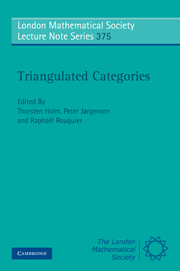Book contents
- Frontmatter
- Contents
- Preface
- Triangulated categories: definitions, properties, and examples
- Cohomology over complete intersections via exterior algebras
- Cluster algebras, quiver representations and triangulated categories
- Localization theory for triangulated categories
- Homological algebra in bivariant K-theory and other triangulated categories. I
- Derived categories and Grothendieck duality
- Derived categories and algebraic geometry
- Triangulated categories for the analysts
- Algebraic versus topological triangulated categories
- Derived categories of coherent sheaves on algebraic varieties
- Rigid dualizing complexes via differential graded algebras (survey)
Algebraic versus topological triangulated categories
Published online by Cambridge University Press: 07 September 2011
- Frontmatter
- Contents
- Preface
- Triangulated categories: definitions, properties, and examples
- Cohomology over complete intersections via exterior algebras
- Cluster algebras, quiver representations and triangulated categories
- Localization theory for triangulated categories
- Homological algebra in bivariant K-theory and other triangulated categories. I
- Derived categories and Grothendieck duality
- Derived categories and algebraic geometry
- Triangulated categories for the analysts
- Algebraic versus topological triangulated categories
- Derived categories of coherent sheaves on algebraic varieties
- Rigid dualizing complexes via differential graded algebras (survey)
Summary
These are extended and updated notes of a talk, the first version of which I gave at the Workshop on Triangulated Categories at the University of Leeds, August 13–19, 2006. These notes are mostly expository and do not contain all proofs; I intend to publish the remaining details elsewhere.
The most commonly known triangulated categories arise from chain complexes in an abelian category by passing to chain homotopy classes or inverting quasi-isomorphisms. Such examples are called ‘algebraic’ because they originate from abelian (or at least additive) categories. Stable homotopy theory produces examples of triangulated categories by quite different means, and in this context the source categories are usually very ‘non-additive’ before passing to homotopy classes of morphisms. Because of their origin I refer to these examples as ‘topological triangulated categories’.
In this note I want to explain some systematic differences between these two kinds of triangulated categories. There are certain properties – defined entirely in terms of the triangulated structure – which hold in all algebraic examples, but which fail in some topological ones. These differences are all torsion phenomena, and rationally there is no difference between algebraic and topological triangulated categories.
A triangulated category is algebraic in the sense of Keller [Ke, 3.6] if it is triangle equivalent to the stable category of a Frobenius category, i.e., an exact category with enough injectives and enough projectives in which injectives and projectives coincide.
- Type
- Chapter
- Information
- Triangulated Categories , pp. 389 - 407Publisher: Cambridge University PressPrint publication year: 2010
- 11
- Cited by

